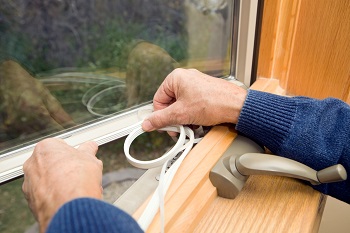

By Julie DeLong, A-1 Freeman Moving Group
 Moving in the winter is a unique experience and if this is your first time, you'll want to prepare yourself for at least a few cold-weather surprises. Along with the usual challenges of making sure you have a clear driveway and sidewalks and turning the heater up before the moving truck arrives, you may also discover that your new home is less thermally insulated than the place you have moved out of.
Moving in the winter is a unique experience and if this is your first time, you'll want to prepare yourself for at least a few cold-weather surprises. Along with the usual challenges of making sure you have a clear driveway and sidewalks and turning the heater up before the moving truck arrives, you may also discover that your new home is less thermally insulated than the place you have moved out of.Insulation is something that is remarkably difficult to assess when choosing and moving to a new home, whether you are renting or buying. The pictures simply don't tell you how warm the rooms are, and open houses are usually arranged so that the home is already warm when potential new residents arrive. You may not realize until your first few nights in the new home that this place has cold drafts, freezing floors, or simply doesn't retain heat the way you expect.
Fortunately, this is an issue homeowners and renters have been facing for centuries and there are several easy solutions for a home that tends to be cold in the winter. Today, we're here to help by outlining the best ways to insulate your home, improve the efficiency of your heating system, and enjoy a cozy winter after moving into your new house.
Windows are the number one most common cause of cold drafts in a home. New double-paned storm windows are great for keeping the cold out and the heat in, but anything else can cause the windows to become an unpleasant avenue for cold to enter your home. Single-pane windows simply transfer the cold directly, and the area around them will be markedly colder. Older double-paned windows may allow cold air to seep through because the insulating seal has deteriorated.
The solution? Stop that cold with thick thermal curtains. Heavy curtains of almost any style will help but specifically, thermal curtains are designed to stop cold in its tracks and keep it from escaping the cold window glass. Your best bet is either curtains that fit neatly into the window frame or curtains that go all the way to the floor.
Hard floors are another source of cold in a new home and are especially noticeable when you're still setting up your furnishings. Stone, concrete, and tile floors can allow cold to transfer through them from the freezing ground beneath, creating a truly chilling sensation under bare and sock-covered feet. Hardwood floors are a little better for insulation, but cold drafts under the doors can still sweep through the house causing cold toes throughout.
The answer to cold floors and floor-level drafts is area rugs. Especially for rooms floored with tile and stone, a rug will add a fluffy layer of insulation that will prevent cold from rising from the floor and keep your feet warm as you walk across the room. Fluffy bath mats serve a similar purpose in bathrooms and you can even use utility rugs that are easy to clean for chilly kitchen floors and outdoor patios.
Cold drafts underneath doors can be a problem no matter what kind of flooring you have if the doors are high enough off the ground. This can be particularly problematic when drafts pass between your front hall where cold gets in into the rest of the house. The solution to door drafts are long sock-shaped items known as draft stoppers. You can easily make your own with a little DIY sewing and a collection of old socks or you can buy them at the store for a very minimal cost. These essentially create a soft buffer under the door that swings easily with the door but stops cold drafts from blowing through the house.
If one or two rooms are particularly cold and you can't figure out why, look at the vents. There is a possibility that the previous resident may have closed specific vents in the house, preventing central heating from getting into these rooms. Make sure all your vents in the home are open to provide even heating or, if there's a room you don't use, close that vent and use a draft stopper to save a little HVAC money on heating that room.
Finally, some homes simply have an uneven heating profile. If one or two rooms just don't get warm enough at night or during the day, consider selective use of a space heater. Space heaters are great and often very powerful little devices that can heat a specific room area. They can ensure your children don't shiver at night, counteract cold window drafts, or they can be used to generally raise the temperature of your home by placing them in central areas and doorways. Just be sure to never leave a space heater on when you leave the house or unattended overnight without an automatic thermostat/timed shutoff feature and be sure to follow all manufacturer guidelines for safe use.
---
Sometimes, after moving to a new home, you find that it is colder than expected. Fortunately, with these simple solutions you can quickly improve the insulation and draft resistance of your home and enjoy a cozy winter in your new place.
Request a free quote

